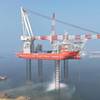A poor operating performance and expensive valuation prompted analysts to downgrade Asia's largest cruise operator Star Cruises Group. The company reported it posted a loss last year following its acquisition of Norwegian cruise firm NCL Holdings. "We have downgraded it into a sell," said Teh Chi-Chang, analyst of SG Securities in Kuala Lumpur. Amelia Mehta of ING Barings also cut her rating from a hold to a sell, putting a price target of 36 cents while Teh cut his target from 78 cents to 46 cents. The group, part of Malaysian conglomerate Genting Bhd, recorded a net loss of $26 million after including interest expense of $84.2 million for NCL's acquisition. Star Cruises said its results were not comparable to 1999 as they included a 10-month contribution from NCL.
The group posted a net loss of $55 million in the fourth quarter partly because of NCL and partly due to the high cost of operations in the new markets of Kobe and Fukuoka and lower occupancy due to adverse weather conditions.
Occupancy fell to 95 percent from 101 percent in 1999, with its average revenue per day in Asia falling 18 percent quarter-on-quarter. (Occupancy can be more than 100 percent because the commonly used formula considers rooms full when occupied by two passengers, but the actual number in a room may be larger.)
Analysts Mehta and Teh, disappointed with Star's fourth quarter performance, both said its shares were traded at unjustified premiums to peers like Carnival Corp. and Royal Caribbean Cruises Ltd., the world's No. 1 and No. 2 cruise group.
In term of price-earnings ratio (P/E), Teh said Star shares valuation at 32 times estimated 2001 earnings, was about twice as high as that of the two industry leaders. Mehta said in a research note that Star deserved a premium because of its wider geographical mix, but the current 114 percent premium to CCL's estimated 2001 earnings was unjustified. "I expected some sort of loss, but I did not expect a huge one," Teh added.
Going forward, Mehta said weak consumer sentiment in the region and competitive pressures in U.S. markets would continue to limit the scope for profit growth. - (Reuters)
Featured videos

Inmarsat Enhances Service to Drive Digitalization

Tracking Foreign Vessels Working in the U.S. Jones Act Market

Inside the Electrified Truckable Tug
Subscribe for
Maritime Reporter E-News
Maritime Reporter E-News is the maritime industry's largest circulation and most authoritative ENews Service, delivered to your Email five times per week









